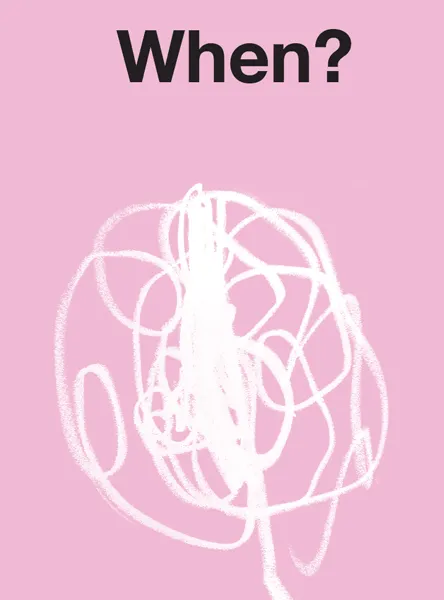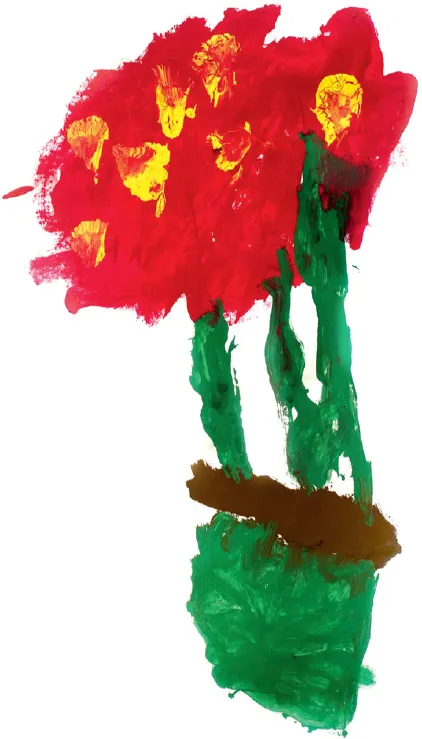![]()
A flower pot with fluffy blossoms painted by Charlie K., aged 6.
![]()
When?
Children’s Drawing Development
As children grow, their knowledge expands, their natural abilities flourish and their learned behaviours, or skills, develop more fully. This is true for many ‘milestone’ activities in a young child’s life, including walking, talking and scribbling, a precursor to drawing and writing. As children progress in each endeavour they typically pass through what are usually referred to as the ‘normal’ stages of development. One caveat, however: stages – and the approximate ages given for each – should be merely viewed as guides, since there is always a broad range of what constitutes ‘normal’. Parents must remember that no two children are exactly alike. Children develop naturally when they are ready to do so – some more quickly than others. And kids who seem to zoom ahead of the pack in one area might very well take their sweet time in another. There is just so much learning and developing going on at the same time when children are young.
Infants usually take their first steps when they are between nine and twelve months old – around the time of their first birthday. But before they are able to stand and walk on their own, they more often than not progress through the preliminary stages of sitting up, crawling and standing, each of which represents a new level of skill and achievement. While babies are gaining greater muscle strength, they must also master challenging feats such as balance, coordination and control. And as they continue to explore their surroundings, they quickly learn which furnishings are steady enough to use for pulling themselves up into a standing position and which ones might topple over easily, resulting in a fall. But regardless of how physically proficient a child might seem, it will certainly take a few more years of growth and development before a child can (or should) start training for athlectics events.
Children’s verbal skills also go through stages as their vocal mechanisms mature and as they interact more and more with their respective environments. Infants begin making noises such as ‘coooh’ and ‘gaaah’ as early as two or three months old and start babbling – that is, experimenting with sounds – as early as four months old. Nowadays, when there are people who post just about every aspect of their lives online, there always seems to be some new video in which a super-cool baby is gurgling and grooving along with his dad’s beatbox rhythms. But before children can have anything close to a real conversation – let alone sing background vocals – their cognitive, linguistic and certain fine motor skills used to control the muscles of the tongue and lips need to be ready. In other words, children must not only develop their ability to produce sounds, but they must be able to recognize simple language, make the mental connection between things and what those things are called, and communicate their wants and needs verbally.
Children’s drawing development follows a similar course. Very young children will begin making marks and scribbling on paper only when they are ready to do so and when they are interested – provided, of course, that their parents or caregivers supply them with a place to work and some age-appropriate drawing materials. Most parents know all too well that if an infant is handed a crayon, s/he may hold on to it for a few seconds, look at it, and then promptly drop it on the floor or pop it into his/her mouth. There are some who might suggest that when infants smear food all over their trays they are, in fact, making pre-writing or pre-drawing gestures. Perhaps. But trying to make one’s mark when one cannot even control a crayon is really no fun at all. Just as with walking and talking, it is not until babies have developed the coordination, strength and hand skills to the levels necessary for grasping writing or drawing tools – usually around eighteen months of age – that they first become interested in making marks.
As toddlers approach their second birthdays they become better at controlling a writing or drawing implement such as a marker or chunky crayon. Even so, at this point, when children ‘draw’ they are primarily experiencing how their body movements and arm motions feel, rather than making any sort of connection between their physical gestures and what happens to appear on the paper. Any marks they do make on the page seem to be instinctive rather than deliberate. Soon, however, these kinds of marks evolve into something different: scribbles that appear as though they have been drawn with great conviction and purpose. And while these may look like meaningless lines, loops and squiggles to an adult, they are very meaningful to a young child. These scribbles represent a child’s first attempts at written/visual communication: recording or ‘writing’ down what s/he is actively thinking and feeling about the world around him/her. To put it even more simply, for very young children, their drawings are their writing.
Viktor Lowenfeld believed a child’s aesthetic, social, physical, intellectual and emotional growth could be seen in his/her art. In other words, children’s drawings not only reflect the child’s cognitive development – conscious intellectual activities such as thinking, reasoning or remembering – but offer clues into the child’s burgeoning skills (motor, language, perceptual, symbol formation) and awareness (sensory, spatial, social, environmental, empathetic, cultural and so on). Building upon the earlier works of Cyril Burt and others, Lowenfeld identified and described the general characteristics of six major, continuous and predictable stages of children’s artistic development, spanning the approximate ages of two years old through adolescence:
1. Scribbling Stage (2 to 4 years): the beginnings of self-expression, which consists of random, disorganized and, later, clustered marks, lines, scribbles and circular shapes.
2. Preschematic Stage (4 to 7 years): the first representational attempts in which children develop specific ideas and symbols – a visual shorthand, so to speak – to represent people, places and things.
3. Schematic Stage (7 to 9 years): the achievement of a form concept – a specific schema, or image, developed by the child to express something – continues with representational symbols, emphasis on figures, objects, composition and colour, use of a baseline.
4. Gang Age (9 to 12 years): dawning realism, with more natural colours, more rigidity and skill at rendering spatial depth.
5. Pseudo-naturalistic Stage (12 to 14 years): the age of reasoning, with increased awareness of the human figure and the environment, use of caricature and increasing rigidity.
6. Adolescent Art (14 to 17 years): the period of decision in which renderings can be more detailed and sophisticated.
According to Lowenfeld, the changes one sees in an individual child’s art reflect the changing ways s/he perceives, represents and functions in the world. However, while the progression from one stage of artistic expression to another can be readily identified by certain specific characteristics in a child’s drawing, knowing exactly why this progress occurs is not so simple. Lowenfeld does note that the gradual movement from one stage to the next seems to coincide with the child’s biological and language structure development. Furthermore, he references the noted Swiss psychologist Jean Piaget’s study Judgment and Reasoning in the Child, citing how Piaget’s four stages of intellectual (or cognitive) development – Sensorimotor (birth to age 18–24 months); Preoperational (toddlers aged 18–24 months to early childhood/age seven); Concrete Operational (ages seven to twelve); and Formal Operational (adolescence to adulthood) – closely parallel the developmental stages of children’s drawing. In other words, one can assume that a child’s growth in art expression is indicative of the development of the child’s thinking. In fact, Lowenfeld suggests that, for young children especially, the very activity of drawing is a way of learning and may, in itself, promote growth.
According to the noted author and drawing professor Betty Edwards, the developmental progression in children’s art is indeed linked to developmental changes in the brain. She notes that lateralization, whereby specific functions are consolidated into one hemisphere of the brain or the other, happens slowly throughout the early childhood years, corresponding to the development of both language skills and symbols in children’s art – around the age of four. In biological psychology (behavioural neuroscience), the brain’s left hemisphere is generally believed to control speech, comprehension, arithmetic and writing. The right hemisphere is thought to control creativity and imagination, musical and artistic endeavours, spatial tasks, and body control and awareness. Edwards suggests that, interestingly, lateralization, which is often complete by the age of ten, coincides with a period of conflict in children’s artistic expression. At around the age of ten, the left (verbal) hemisphere of the brain becomes dominant and the use of names and symbols takes precedence over spatial perceptions. This, she feels, interferes with children’s ability to ‘accurately’ draw things in the way the...


